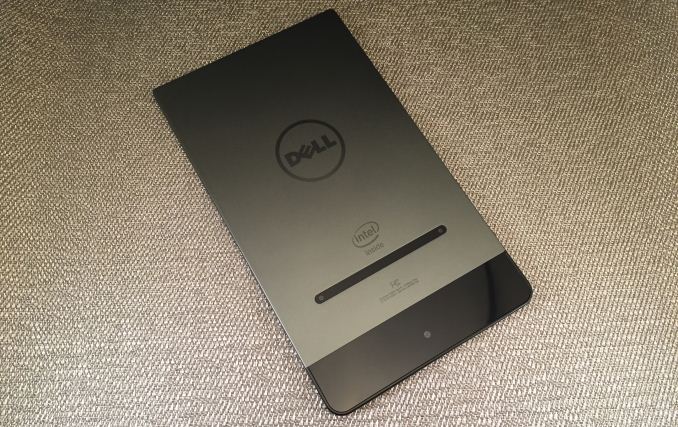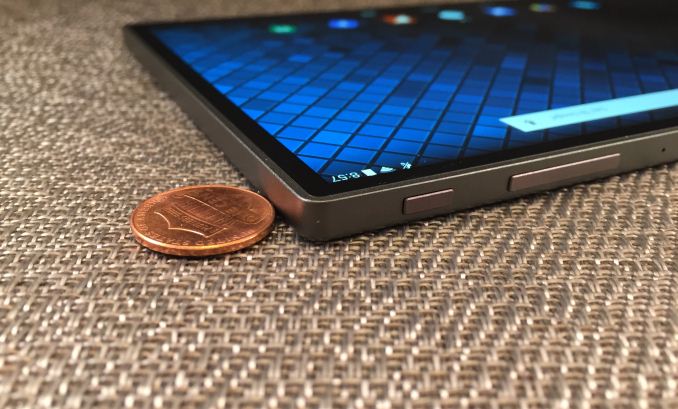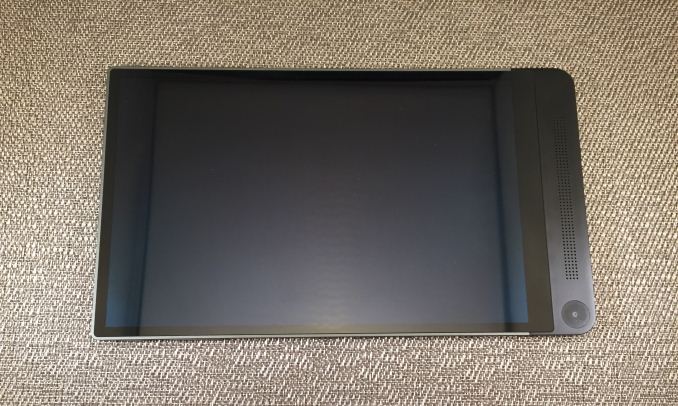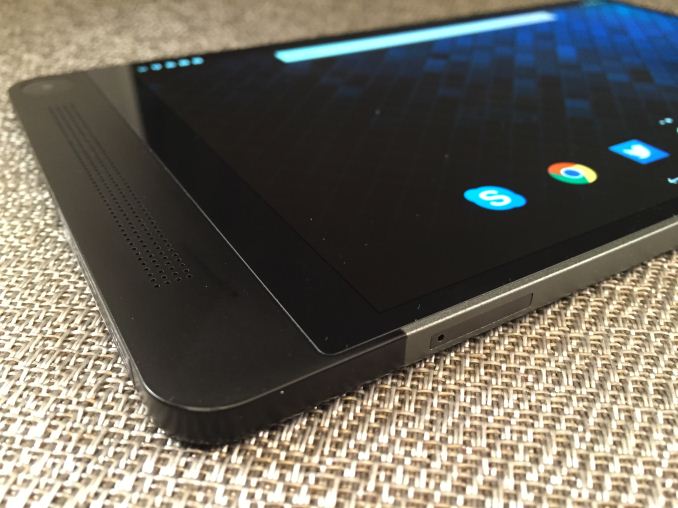The Dell Venue 8 7000 Series Review
by Brandon Chester on March 12, 2015 8:00 AM EST- Posted in
- Tablets
- Dell
- Android
- Mobile
- Venue 8 7000

Five years ago, the first of what we would call modern tablet computers were released to the world. What is now an entire product category was originally seen with massive skepticism by many consumers, analysts, and journalists. Even those who had high hopes for the future of tablets could not have predicted their meteoric rise in popularity and ubiquity.
Although tablets are still derided by many as being useless for productivity work, there are many cases where a consumer has been able to not just supplement, but replace their traditional computer with a tablet. Of course, as tablets made by companies in the mobile space replace traditional computers, the producers of those computers are faced with a problem of maintaining profit and relevance. The inevitable move was for PC companies to produce their own tablets to compete with their new competition.
This brings us to the Dell Venue 8 7000 Series tablet, also known as the Dell Venue 8 7840. Although there have been other Venue 8 tablets, for the remainder of the review I will refer to the Dell Venue 8 7840 as the Venue 8 as the full name is quite long and there shouldn't be any risk of confusion with older Venue 8 tablets. Dell is actually not a brand new player in the tablet space, nor are they new to the mobile space.
Some people may remember the Dell Streak 5, which was a 5" phone that could be called one of the first phablets on the market. However, Dell is still not a well known player in the mobile space despite their previous attempts to break into it. On paper, the Venue 8 has all the attributes required of a flagship tablet, but whether or not it's enough to make Dell a serious contender remains to be seen. Before discussing the design of the Venue 8, I've laid out its specifications below to give an overview of how the Venue 8 stacks up to the competition.
| Dell Venue 8 7840 | |
| SoC | Intel Atom Z3580 Moorefield quad core Atom with 2.33GHz burst speed, PowerVR G6430 |
| RAM/NAND | 2GB LPDDR3, 16GB NAND + microSDXC |
| Display | 8.4" 2560x1600 AMOLED |
| Dimensions | 215.8 x 124.4 x 6.0 mm, 306g |
| Camera | 8MP Rear Facing + 2x 720p Depth Cameras 2MP Front Facing |
| Battery | 5900mAh (21Wh) |
| OS | Android 4.4.4 KitKat |
| Connectivity | 1x1 802.11a/b/g/n/ac + BT 4.0 , USB2.0 LTE SKU Available |
| Price | Starting at $399 |
As you can see, the Venue 8 is a high end device in most areas, at least when evaluated on paper. The limited storage configuration of 16GB is one of the few question marks, though the microSD slot helps; the GPU is also going to be potentially limiting. Note that Dell also offers an optional wireless keyboard/case as an accessory. The rest of the review will determine how well these specifications translate into a good real world experience, but before jumping into the technical details it's important to discuss the design and ergonomics of the Venue 8.
One big selling point for the Venue 8 is that it's currently the thinnest tablet in the world according to Dell. Both Apple and Sony have tablet offerings that are 6.1mm thick, but Dell has shaved off that decimal point and made a tablet that is exactly 6mm thick across the entire chassis. I can't really tell the difference between the thickness of the Venue 8 and the iPad Air 2, but both devices are remarkably thin. The Venue 8 feels even more impressive than the iPad at times because it's smaller and significantly lighter in addition to being thinner. The bulk of the chassis is made of aluminum, with a small plastic region at the bottom to house the speakers and camera. The whole device feels great in the hand, and the aluminum feels solid and sturdy.
However, there is a unique aspect of the Venue 8's design that needs to be addressed, which are the unconventional bezel proportions and speaker positioning. On most tablets, you'll see a bezel of equal width on every side, or a a pair of equal bezels on the top of bottom, and a pair of equal thinner bezels on the left and right sides that are thinner than those on the top and bottom. The Venue 8 with its Infinity Display instead opts to use very thin bezels of equal width on the top, left, and right, and a thicker bezel on the bottom. This is necessary to provide space for the various circuitry and display drivers that are required. In addition, Dell has placed the front-facing camera and a pair of stereo speakers in a section beneath bottom bezel.
This leads to an unconventional and unfortunately unbalanced bezel design, and it can cause some issues when holding the tablet. In portrait mode the fact that there's a larger bezel and a speaker at the bottom of the tablet doesn't pose much of an issue, but in landscape mode it makes it uncomfortable to hold. It's hard to hold the Venue 8 in landscape without it feeling uneven. This is exacerbated by the fact that the bezel on top of the tablet is extremely thin.
The thinness of the other bezels can also pose their own issues with having fingers rest on the display. When Apple first used asymmetric bezels on an iPad with the iPad Mini, they tweaked the touch rejection in iOS to account for the fact that fingers were more likely to be resting on the display. Android has no such accommodation, and there have been instances where I find myself unable to scroll or accidentally zooming because one of my other fingers is resting on the display and being detected as touch input.
Overall, I think the Venue 8 is a well designed device with exceptional build quality. It feels remarkably thin and light in the hand, and its flat edges are visually striking while still remaining ergonomic due to the tablet's thinness. The aluminum construction also ensures that there's not even the slightest bit of flex to the chassis. Like every device, it's imperfect. The bezel design is visually impressive, but hampered by technological limitations and some software issues. I also have mixed feelings about the camera placements. Despite its issues, the Venue 8 still remains a tablet that both looks and feels like a premium device.













89 Comments
View All Comments
darkich - Friday, March 13, 2015 - link
"Intel will be somewhere below 5 by then."Oh I see, you're nothing but a TROLL
Michael Bay - Saturday, March 14, 2015 - link
So all you have is an eteranl looser`s excuse.Typical of ARM fanatics.
Michael Bay - Friday, March 13, 2015 - link
Oh please. Intel has to improve a much more complex architecture and simultaneously drive power consumption down, while ARM is touching the heat ceiling on current complexity. Those issues will only exacerbate in next iterations.GNUminex_l_cowsay - Thursday, March 12, 2015 - link
Considering that there isn't much you can do with a tablet besides viewing content. How could something with such a bad screen possibly be useful?extide - Thursday, March 12, 2015 - link
Wow, those CPU scores are terrible. Even nVidia can roll a custom ARM core and be faster, and I'm not even talking about the GPU part, only CPU. This is sad Intel, c'mon you're letting me down! ATOM NEEDS TO GO. Use Core-M and then for the cheaper segments Intel needs to roll a custom ARM-v8 core. It's time!djc208 - Thursday, March 12, 2015 - link
Remember that in some cases the Atom CPU has to do a real-time conversion from ARM to X86 on any app that doesn't provide an X86 build. I notice that on my MeMo Pad some things just don't run, or don't run right even though they're fine on my phone. Admittedly the MeMo has far less RAM, but it's still glitchy on some apps. But it also means that some stuff just isn't as responsive because the CPU is trying to translate and run at the same time. Which admittedly is kind of what the Tegra K1 is doing too, just without the optimization library.extide - Thursday, March 12, 2015 - link
That only happens on apps that are native code, which is basically only things like full-screen 3d games. All of the main google apps, browsers, and common stuff you use is java, so it has no additional translation overhead compared to running on ARM.However, the truth is that it's the end result that matters.
tipoo - Thursday, March 12, 2015 - link
Browsers aren't java, they're native.staiaoman - Thursday, March 12, 2015 - link
and THIS is why we patiently wait for anand's review before buying a tablet, instead of going off of the "FIRST!" articles from other sites. Well done, guys. Thorough as always.Refuge - Friday, March 13, 2015 - link
Haha agreed, they are my guiding light.